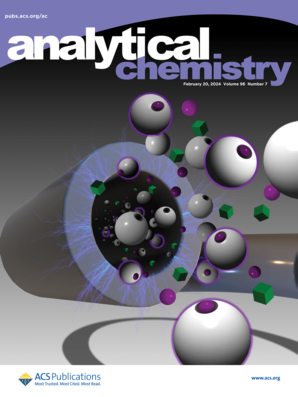Development of Novel Multiplex Detection Platforms Based on Multiepitope Nanobody Pairs for Rapid Screening of Waterborne Pathogens.
IF 6.7
1区 化学
Q1 CHEMISTRY, ANALYTICAL
引用次数: 0
Abstract
The rapid and multiplexed detection of waterborne viruses is crucial for infection prevention. However, current methods are limited by low-quality probes, instrument dependency, and time-consuming procedures. In this study, we developed a high-performance, nanobody pair-based, multichannel homogeneous platform for the simultaneous and rapid detection of three viruses─SARS-CoV-2, norovirus, and influenza A virus─in aquatic environments. To identify robust and sensitive multiepitope nanobody pairs for these viruses, we utilized pressure-assisted screening and docking techniques. For multichannel detection, we synthesized three distinct SiO2@TQD types with unique excitation wavelengths, each acting as an independent signal label. By integrating these multichannel antibody arrays and signal labels into a unified platform, we developed a homogeneous sensor capable of detecting all three viruses within 30 min. The system demonstrated detection limits of as low as 1.56 pg/mL for the SARS-CoV-2 antigen, 0.1 pg/mL for the norovirus antigen, and 0.39 pg/mL for the influenza A virus antigen, surpassing conventional antigen detection kits with a sensitivity enhancement of 160.26-6.25 × 104-fold. Notable advantages include exceptional specificity, accuracy, and stability. This work not only provides a transformative solution for monitoring waterborne pathogens but also establishes a versatile framework for developing multichannel detection platforms for other infectious agents.基于多表位纳米体对的水传播病原体快速筛选多重检测平台的建立。
水传播病毒的快速和多重检测对于预防感染至关重要。然而,目前的方法受到低质量探针、仪器依赖性和耗时程序的限制。在这项研究中,我们开发了一种高性能、基于纳米体对的多通道同质平台,用于同时快速检测水生环境中的三种病毒——SARS-CoV-2、诺如病毒和甲型流感病毒。为了鉴定这些病毒的健壮和敏感的多表位纳米体对,我们利用压力辅助筛选和对接技术。对于多通道检测,我们合成了三种具有独特激发波长的不同SiO2@TQD类型,每种类型都作为独立的信号标签。通过将这些多通道抗体阵列和信号标签整合到一个统一的平台上,我们开发了一种能够在30分钟内检测所有三种病毒的均匀传感器。该系统对SARS-CoV-2抗原的检测限低至1.56 pg/mL,对诺如病毒抗原的检测限低至0.1 pg/mL,对甲型流感病毒抗原的检测限低至0.39 pg/mL,灵敏度提高了160.26-6.25 × 104倍。显著的优点包括特殊的特异性、准确性和稳定性。这项工作不仅为监测水传播病原体提供了一种变革性的解决方案,而且为开发其他感染病原体的多通道检测平台建立了一个通用框架。
本文章由计算机程序翻译,如有差异,请以英文原文为准。
求助全文
约1分钟内获得全文
求助全文
来源期刊

Analytical Chemistry
化学-分析化学
CiteScore
12.10
自引率
12.20%
发文量
1949
审稿时长
1.4 months
期刊介绍:
Analytical Chemistry, a peer-reviewed research journal, focuses on disseminating new and original knowledge across all branches of analytical chemistry. Fundamental articles may explore general principles of chemical measurement science and need not directly address existing or potential analytical methodology. They can be entirely theoretical or report experimental results. Contributions may cover various phases of analytical operations, including sampling, bioanalysis, electrochemistry, mass spectrometry, microscale and nanoscale systems, environmental analysis, separations, spectroscopy, chemical reactions and selectivity, instrumentation, imaging, surface analysis, and data processing. Papers discussing known analytical methods should present a significant, original application of the method, a notable improvement, or results on an important analyte.
 求助内容:
求助内容: 应助结果提醒方式:
应助结果提醒方式:


